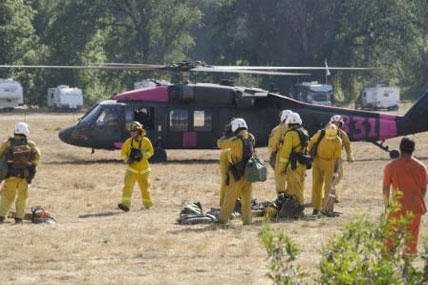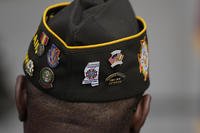SACRAMENTO, Calif. - In what has become a near-annual mission for the California National Guard (CNG), Army and Air Force aviators are dousing wildfires across Northern California, where they soon may be joined by Army Guard firefighting hand crews on the ground.
Army Guard helicopter crews mobilized July 31 to support wildland firefighting efforts as dozens of fires threatened several Northern California communities. As of Aug. 5, the crews had dropped about 430 buckets, or 2.5 million pounds, of water on the Day Fire in Modoc County and the Lodge Complex Fire in Mendocino County.
"Working the fire mission is the most [challenging] and requires the greatest skill level of any mission we have stateside," said Sgt. Joshua Esquivel, a helicopter crew chief for Company B, 1st Battalion, 140th Aviation Regiment, who deployed to Iraq with his unit. "The terrain here is very difficult, and having already built that trust and confidence in the crew you're working with … will get you through those hairy situations.”
The California Army Guard deployed 18 helicopters beginning July 31 to support the California Department of Forestry and Fire Protection (CAL FIRE) and the California Office of Emergency Services (Cal OES). Two days later the California Air Guard deployed two C-130J planes equipped with Modular Airborne Fire Fighting Systems (MAFFS).
The MAFFS equipment, which is owned by the U.S. Forest Service but flown on National Guard planes, can drop up to 3,000 gallons of water or fire retardant through a nozzle on the side of the plane. Col. David Bakos, commander of the Air Guard’s 146th Airlift Wing, said many of the troops flying the MAFFS mission just returned from an overseas deployment to Southwest Asia.
"Our air crew and support personnel are loyal to this mission and remain ready to respond at a moment's notice,” Bakos said. “I am so proud of their commitment and dedication."
Chief Clare Frank, CAL FIRE's deputy director for fire protection, said the Guard crews and aircraft were in place and ready to fly within 24 hours after CAL FIRE issued its request for assistance.
"Our 43-year relationship with the National Guard allows for a seamless interface when these activations occur,” she said.
In addition to the two C-130s, the aircraft include 14 UH-60 Black Hawk and CH-47 Chinook helicopters equipped with 660-gallon and 2,000-gallon water buckets, respectively, plus one Black Hawk dedicated for medical evacuation duty and three UH-72 Lakota helicopters, which stream near-real-time video and thermal imagery of the fires to incident commanders on the ground.
Lt. Col. Mark Kampa, a helicopter instructor pilot based at Joint Forces Training Base Los Alamitos, said that in addition to helping the people of California, this mission is helping CNG aviators improve their skills.
"The level of [intensity] is much closer to a wartime environment [than training],” Kampa said. “These operations require precision flying, and that's hard to teach in a training environment."
On Aug. 4, more than 260 soldiers arrived at the Guard training installation Camp Roberts for four days of intensive CAL FIRE-led instruction in case CNG troops are needed to work fire lines on the ground. The training includes two days of classroom instruction followed by two days of work in the field with hand tools.
If activated to fight fires, the hand crews will work to create fire breaks — gaps in vegetation that act as a barrier to slow or stop the progress of a fire — and to mop up hot spots and small blazes that remain after a large fire has passed through an area.
“Our primary mission is to protect the people of the great state of California, and we train year-round to respond to emergencies such as this,” said Maj. Gen. David S. Baldwin, adjutant general of the California National Guard. “Whether on the ground or in the air, our soldiers and airmen are always ready to fight the blazes that threaten our state each year.”
Chief Ken Pimlott, CAL FIRE director, said the extreme drought conditions faced by the state this year make access to Cal Guard resources even more critical than in a typical wildfire season.
“The recent lightning activity in Northern California has sparked over a dozen fires,” he said. “Our well-exercised and long-standing relationship with the California National Guard allows for rapid, effective deployment of these additional resources during times of elevated fire activity.”
California National Guard aircraft dropped nearly 1.5 million gallons of fire retardant and water during nearly 1,500 aerial drops in last year’s fire season, predominantly across California and the Western States.
Esquivel said he and the other members of the Cal Guard are excited to be able to support such an important emergency response.
"You really get a sense of accomplishment on missions like these, where you're out here helping people," he said.
Don't Miss a Single Military.com Story
To read the full article and get exclusive benefits, sign up today.
It’s FREE
Why am I seeing this? Visit our FAQs


























